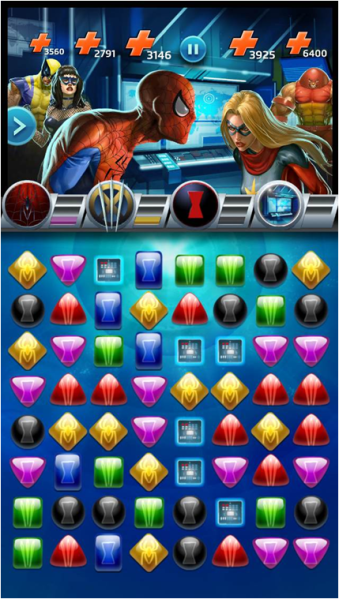Albert Reed is the CEO and cofounder of Demiurge Studios. Follow the entire series here.
Since we launched Marvel Puzzle Quest along with our partners at D3Publisher in late August, we’ve been furiously optimizing the game, chasing the mythical $1 ARPDAU (Average Revenue Per Daily Active User). As we finally rang that bell in February (if only for a day), it seemed like a good time to share how we got there.
The team at Demiurge Studios has always been struck by how hard it is to look back on the history of a successful game and correlate changes in gameplay to changes in financial performance. In this series of posts, I’ll work to demystify these optimizations and detail many of the design improvements Demiurge Studios implemented in Marvel Puzzle Quest over the last 5 months and which have brought us to where we are today.
First, some background. Marvel Puzzle Quest takes the match-3/role-playing gameplay of the Nintendo DS sleeper hit Puzzle Quest, applies the cast of Marvel superheroes, and injects it with the design of a free-to-play card-battler. The result is a game that feels a bit like the long-lost cousin of GungHo’s hit, Puzzles and Dragons.
Throughout this series, the stats I cite are from iOS. The game is also out on Android and PC/Steam. Dollars are in gross USD spent by customers.
When we launched Marvel Puzzle Quest worldwide in October, retention was pretty strong. Our Day 1 for organic users (those you didn’t download the game from an ad) was comfortably around 40 percent, and Day 7 was right where we wanted it — about half of that. In mid-October, we moved our focus to improving ARPDAU, which was a respectable but not sufficient $0.21 at the time.
Marvel Puzzle Quest’s economy is pretty similar to the standard dual-currency free to play games. The two currencies in Marvel Puzzle Quest are:
- Iso-8, which is essential XP that levels up characters. The currency scales a bit as players progress, but we attempt to peg this at a constant inflow per minute played. It’s a classic soft currency.
- Hero Points, which are our hard currency. But unlike most free-to-play games, we’re pretty liberal in giving them out. We aim to regulate the inflow of these into the economy by engagement — regular daily play.
Hero Points can be spent in a number of ways within the game’s economy. One optimization we’ve been undertaking is adding interesting new mechanics that hang off of the Hero Point economy. As of the latest version of the game, players can spend Hero Points in a number of places:
- Roster Slots: Enable players to have more heroes in their roster. They sell for Hero Points.
- Cover Packs: These are our “cards.” They come from random roll packs like a standard card battler but also as loot at the end of missions and as prizes from events. When players get a card for the first time, they can add that character to their roster. Each card has an associated power, and you can fuse up to 13 cards of the same character together to upgrade that character’s powers. In general, they sell for Hero Points.
- Ability Upgrades: To unlock a character fully, you need to pour 13 ability points into the character. Once you have an ability unlocked (via fusing cover together), you can upgrade those abilities through further fusing or by directly purchasing the upgrade for Hero Points.
- Boosts: These are consumable upgrades that last a single fight. They are sold for either Hero Points or Iso-8 depending on how big of an upgrade they provide. They’re dropped from missions and as event rewards.
- Health Packs: Modeled after “lives” in Candy Crush Saga, these let you instantly heal one of your characters so you can play again. They regenerate for free over time up to a cap. They’re dropped or gifted from social hooks and sold for Hero Points. From the beginning we didn’t want to have an energy mechanic in Marvel Puzzle Quest. We’re on the core side of mid-core, and we felt our fans would appreciate it if their session length was regulated by skill more than energy tends to allow. In place of energy, characters take time to heal up between fights. If you take less damage in a battle, you can play more often.
- Event Buy-Ins: A new feature to the game, players can spend Hero Points for entry in special events.
Out of the above options, over the past two weeks, players have spent the most Hero Points on cover packs and roster slots, which you can see outlined below:
Keep in mind that within Marvel Puzzle Quest, we’re fairly generous with Hero Points so this doesn’t map to actual spending habits of our players. All of our players buy items like Roster Slots, while people who spent money on IAPs are tend to be ones who buy Boosts.
By the end of October, we had followed most of the best practices that we knew of. We had large currency packs, nice low-friction purchasing UI flow, and a First-Time User Experience (FTUE) that clearly explained the value of our IAPs. The game was performing “just OK,” so we began a series of carefully targeted optimizations.
We’ll cover the first of those, improvements to the Cover Store, in Part 2, which runs Thursday.
As cofounder and CEO, Albert Reed has held the reins for over a decade at Demiurge Studios, a game development house focused on innovative, high-quality games for all platforms. Find him on Twitter at @almnop.
VentureBeat's mission is to be a digital town square for technical decision-makers to gain knowledge about transformative enterprise technology and transact. Learn More



